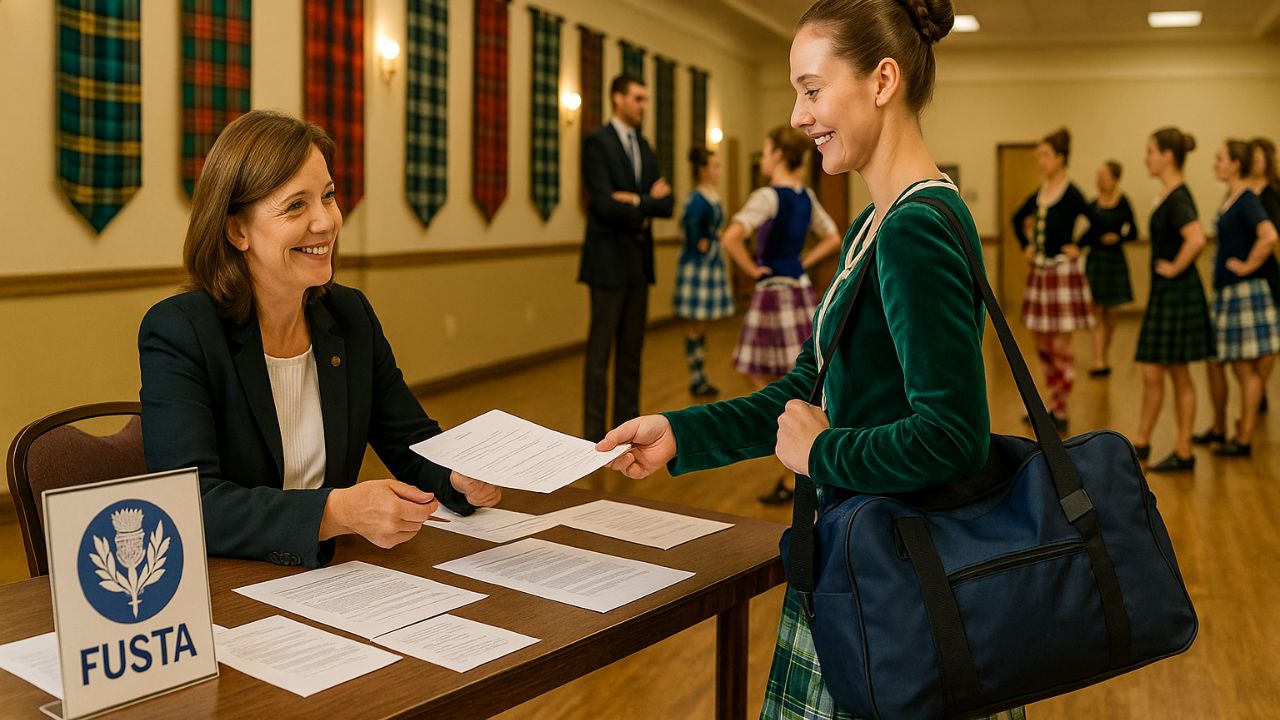Whether you are new to Scottish Highland Dancing or preparing for your next competition season, understanding the FUSTA dancer registration process is essential.
From securing your first registration card to learning how to use it for competitions worldwide, these rules ensure fairness, consistency, and adherence to Scottish Official Board of Highland Dancing (SOBHD) standards.
This detailed guide covers everything you need to know about registration forms, cards, and the steps involved in competing under FUSTA rules.
Why Registration Matters in Highland Dancing
Dancer registration is not just paperwork — it’s the foundation of fair competition. By registering with FUSTA (the official U.S. registration agent for SOBHD), dancers are placed in the correct competitive category and recognized internationally.
Registration cards ensure:
- Dancers compete against others of similar ability
- Records of competition results are maintained accurately
- International competition eligibility is clear
Where to Get a FUSTA Dancer Registration Form
Dancers can obtain registration forms in two ways:
- From Your Teacher – If they are a FUSTA member, they can provide and sign the form.
- Through the FUSTA Website – Visit the Registration Information page, click on the “Registration Forms” icon, find your region, and select the appropriate form.
Note: All forms must be signed by your teacher before submission.
Why Beginners & Novices Keep Their Original Card
Beginner and Novice dancers do not receive a new card each year. This preserves the original competition stamps until they earn the six qualifying stamps required to move up a level.
- Beginner & Novice: Keep the same card until promotion.
- Intermediate & Premier: Receive a new card annually.
Purpose of the FUSTA Registration Card
While it is issued by FUSTA in the U.S., the card is functionally identical to those issued by ScotDance Canada or SOBHD in Scotland. Its primary purpose is to allow dancers to:
- Compete in any SOBHD-sanctioned event worldwide
- Be placed in the correct category (Primary, Beginner, Novice, Intermediate, or Premier)
- Verify eligibility with competition organizers
Using Your Card for International Competitions
Your FUSTA card is valid for any SOBHD-approved competition around the globe.
To find competition listings:
- Scotland: Visit SOBHD’s website for Championship schedules.
- Games Listings: The Clan MacLachlan Association of North America’s website provides comprehensive listings, although not all events may be SOBHD-approved.
FUSTA Card Types and Their Validity
| Category | Age Requirement | Card Renewal | Purpose |
|---|---|---|---|
| Primary | Under 7 | Until move-up | For youngest competitors; optional early advancement |
| Beginner | 7+ until qualified for Novice | Until move-up | Entry-level competitive card |
| Novice | After Beginner qualifications | Until move-up | Mid-level competition category |
| Intermediate | After Novice qualifications | Annual renewal | Prepares dancers for Premier level |
| Premier | After Intermediate qualifications | Annual renewal | Final and highest competition level |
How to Move Up Levels
Dancers move through levels based on performance:
- Primary: Under 7 years old, may advance early but cannot return to Primary.
- Beginner → Novice → Intermediate: Requires 1st, 2nd, or 3rd place in six separate competitions or completion of 12 months from the first win stamp.
- Premier: Final level; no further advancement.
Once a dancer moves up, there is no going back.
Photo Requirements for Registration
When applying or renewing, dancers must include a recent photo.
- Beginner/Novice cards may only get a sticker update instead of a full replacement.
- Photos help maintain security, prevent card misuse, and ensure the card is valid for identification at events.
Common Card Issues and Solutions
Lost or Delayed Cards
- Processing typically takes three weeks.
- If delayed beyond that, contact the National Registration Secretary.
Competing Outside Your Home Region
- If attending college or moving temporarily, you can compete in your new region if you have resided there for at least six months before the Regional Championship.
- A formal “Request for Change of Regional Registration” must be submitted annually.
Rush Requests
- Some registrars can process urgent requests, but approval depends on their workload. Always contact them before sending an urgent application.
Tips for a Smooth Registration Process
- Submit forms early to avoid missing competitions
- Keep a digital scan of your registration card in case of loss
- Track your competition stamps carefully
- Coordinate with your teacher for group submissions if allowed by your regional registrar
FUSTA dancer registration is more than an administrative step — it is your passport to competitive Highland dancing at a national and international level.
Understanding how to obtain your card, maintain its validity, and navigate special circumstances will ensure you stay competition-ready year-round.
By following the proper procedures, you safeguard both your eligibility and the fairness of the sport.
FAQs
Can I compete without a FUSTA registration card?
No. A valid registration card is required for all SOBHD-sanctioned competitions.
How often do I need to renew my registration card?
Beginners and Novices keep the same card until they move up, while Intermediates and Premiers renew annually.
Can I register directly with SOBHD instead of FUSTA?
No. In the U.S., all SOBHD competition registrations must go through FUSTA.



